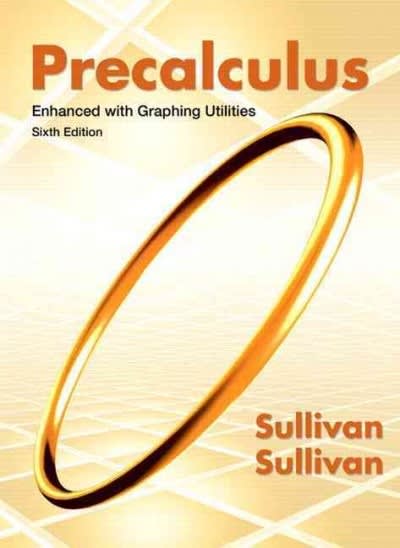Symbolic answers must be entered using notation similar to the examples given below. If you enter decimal numbers for questions that indicate that a symbolic answer is required, it will be marked as zero, regardless of whether the decimal number is correct or not. Integer numbers (positive, negative, and O) are allowed. Below are some examples. Example Math Expression How to Enter the Answer 2 -3/5 infinity 2\"8+l 2+exp(5) 5*pi/9 4/7-3*ln (2) sqrt(2) 5"(l/3) sqrt(5exp(3)+2*ln(7*pi)) fac(5) Answer Format Unless otherwise noted, enter answers as: - Whole Numbers - Exact Fractions (e.g., 2/3 or -5/4) or (only when necessary): - Decimals correct to six decimal places The use of decimal numbers is discouraged because decimal numbers are subject to rounding errors, which could cost you marks! Epics: Sections 2.5 and 2.7 in the textbook. PrOblem # 1: For What value of the constant c is the following function continuous at x = -5? m) = {6:5 ifx5 (andxg0) c ifx=5 x I w. ' |:| Enter your answer symbo'ica'w' Problem #1' as in these examples Just Save Submlt Problem #1 for Gradlng Problem #1 Attempt #1 Attempt #2 Attempt #3 Your Answer: Your Mark: Problem #2: Evaluate the following limit hm V7o4(x+h) - V704x 110 h Enter your answer as a symbolic Problem #2: :l function of x, as in these examples Pr0blem #3: Consider the following equations. In each case suppose that we apply the Intermediate Value Theorem using the interval [0, 1]. (i.e., we take a = 0, b = 1 in the Intermediate Value Theorem.) (i) x2+x-4 = 0 (ii) 25' = x-3 (iii) ln(x+1) = Z-Zx For which equations does the Intermediate Value Theorem conclude that there must be a root of the equation in the interval (0, l)? (A) (ii) only (B) (iii) only (C) (i) and (iii) (D) (i) and (ii) (E) all of them (F) (i) only (G) none of them (H) (ii) and (iii) Problem #3: Select V Just Save l l Submit Problem #3 for Grading Problem #3 Your Answer: Your Mark: Attempt #1 Attempt #2 Attempt #3 PrOblem #4: Suppose that f is continuous on [0, 6] and that the only solutions of the equation f (x) = 3 are x = 1 and x = 5. If f (4) = 2, then which of the following statements must be true? (i) f (2) 3 (iii) f (6) > 3 (A) (ii) only (B) (iii) only (C) (i) and (iii) (D) (i) only (E) none of them (F) all of them (G) (i) and (ii) (H) (ii) and (iii) Problem #4: Just Save l Submit Problem #4 for Grading Problem #5: (a) If an equation of the tangent line to the curve y = f(x) at the point where a = 10 is y = 9x - 4, find f(10) and f'(10). (b) If the tangent line to y = f(x) at (-2, -1) passes through the point (5, 7), find f(-2) and f'(-2). Problem #5(a): separate your answers with a comma. (Your answers MUST be in the correct order.) Problem #5(b): separate your answers with a comma. (Your answers MUST be in the correct order.) Just Save Submit Problem #5 for Grading Problem #5 Attempt #1 Attempt #2 Attempt #3 Your Answer: | 5(a) 5(a 5(a) 5 (b 5 (b 5 ( b ) Your Mark: |5(a) 5(a 5(a 5 ( b ) 5 ( b ) 5 ( b ) Problem #6: Let f(x) = cosx. Which of the following would you use to calculate f'(-7/2) using the definition of derivative (i.e., first principles)? (A) lim sin(7/2 + h) (B) lim COS(7/2 + h) (C) lim Cos(7/2 + h) (D) lim sin(7/2 + h) + 1 h h- 0 h h-0 h h-0 h (E) lim Cos(7/2 + h) - 1 (F) lim sin(7/2 + h) - 1 (G) lim COs(7/2 + h) + 1 (H) lim sin(7/2 + h) h- h h-0 h h-0 h h-0 h Problem #6: Select v Just Save Submit Problem #6 for Grading Problem #6 Attempt # 1 Attempt #2 Attempt #3 Your Answer: Your Mark:Problem #7: The following limit represents the derivative of some function fat some number a. Find such an f and a. lim V4 +h - 2 h ( A) f ( x) = Vxth - 2, a = 4 ( B)f ( x) = Vx+ h, a= 4 ( C)f ( x) = Vx, a= 2+h (D)f(x) = Vx, a=2 ( E) f ( x) = V x, a = 4 ( F) f ( x) = Vx, a = 4+h ( G)f (x) = Vx - 2, a =2 (H)f (x) = Vxth, a=2 Problem #7: Select v Just Save Submit Problem #7 for Grading Problem #7 Attempt # 1 Attempt #2 Attempt #3 Your Answer: Your Mark: Problem #8: Which of the below graphs is an example of a function that satisfies the following conditions? g'(0) = 0, g'(1) =-1,g'(2) = 0,g'(3) = 1,g'(4) = 1 (A) (B) - 1 0 1 3 3 4 5(A) (B) -1 0 3 4 5 N (C) (D) - 1 0 1 N 3 5 (E) (F) 3 4 5 -1 1 3 N (G) (H) -1 0 N 3 5 N 3 X












